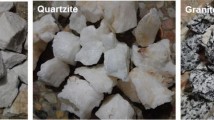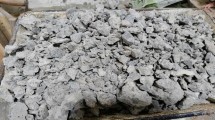Abstract
The nature of aggregates has an important influence on the behaviour of concrete at high temperature. The aggregates used in concrete are classified into two categories: siliceous (S) and calcareous (C). Most publications and Eurocode 2 Part 1–2 underline concrete containing C aggregates have a better thermal resistance in comparison to concrete with S aggregate. Recent studies show that rocks of identical chemical nature can have different behaviour during a temperature rise. Therefore, the improvement for understanding the thermal damage process of aggregates is necessary. An experimental study performed on three different aggregates (limestone, flint and quartzite) underwent heating–cooling cycles at 150, 300, 450, 600 and 750 °C is discussed in this paper. For a same S nature, the flint showed a spalling phenomenon from 300 to 500 °C, while quartzite had a good thermal stability up to 750 °C. C aggregates presented instability due to decarbonation/hydration after the heating/cooling cycle at 750 °C. The physico-chemical, mineralogical and microstructural evolutions of these aggregates with temperature were analysed to better understand the instability process of concrete aggregates. The evolution of flint damage is especially described by a series of observations of cracking from macroscopic to nanoscopic scale through microscopic scale. Aggregates have a high temperature behaviour very different depending on their physicochemical properties. Distinguishing aggregates according to their mineralogical nature only may not completely be sufficient to anticipate their thermal stability. The distinction between S versus C prescribed by the Eurocode 2 Part 1–2 for calculating concrete compressive strength at elevated temperature is not sufficiently precise or relevant.
























Similar content being viewed by others
References
Aguilar Reyes BO (2004) Etude microstructurale des opales: application à la destabilisation par blanchissement. Thèse de doctorat de l’Université de Nantes
Bamonte P, Cangiano S, Felicetti R, Gambarova PG, Billi R, Busnelli F, Quaglia M (2007) Thermomechanical characterization of concrete mixes suitable for the rehabilitation of fire-damaged tunnel linings. Stud Res 27:233–277
Bazant ZP, Kaplan MF (1996) Concrete at high temperature: material properties and mathematical models. Longman Group Limited, London
Brindley GW, Brown G (1980) Crystal structures of clay minerals and their X-ray identification. Mineralogical Society, London
Brodie-Linder N, Dosseh G, Alba-Simionesco C, Audonnet F, Impéror-Clerc M (2008) SBA-15 synthesis: are there lasting effects of temperature change within the first 10 min of TEOS polymerization? Mater Chem Phys 108:73–81
CEN (2004) European Committee for Standardization EN 1992-1.2. In: Eurocode 2: design of concrete structures. CEN, Brussels
Deer WA, Howie RA, Zussman J (1992) An introduction to the rock-forming minerals. Longman Scientific and Technical, London
Domanski M, Webb JA (1992) Effect of heat treatment on siliceous rocks used in prehistoric lithic technology. J Archaeol Sci 19:601–614
Domanski M, Webb JA, Boland J (1994) Mechanical properties of stone artefacts materials and the effect of heat treatment. Archaeometry 36:177–208
Domanski M, Webb J, Glaisher R, Gurba J, Libera J, Zakościelna A (2009) Heat treatment of Polish flints. J Archaeol Sci 36:1400–1408
Dunlop D, Özdemir Ö (1997) Rock magnetism: fundamentals and frontiers. Cambridge University Press, Cambridge
Dupain R, Lanchon R, Saint-Arroman JC (2000) Granulats, Sols, Ciments et Bétons, Caractérisation des matériaux de génie civil par les essais de laboratoire, 2nd edn. Asteilla, Paris
Flenniken JJ, Garrison EJ (1975) Thermally altered novaculite and stone tool manufacturing techniques. J Field Archaeol 2:125–131
Fu YF, Wong YL, Tang CA, Poon CS (2004) Thermal induced stress and associated cracking in cement-based composite at elevated temperatures—Part I: thermal cracking around single inclusion. Cem Concr Compos 26:99–111
Griffiths DR, Bergman CA, Clayton CJ, Ohnuma K, Robins GV, Seeley NJ (1987) Experimental investigation of the heat treatment of flint. Cambridge University Press, Cambridge, pp 43–52
Jouenne CA (1980) Traité de céramiques et matériaux minéraux. Septima, Paris
Khoury GA, Anderberg Y, Both K, Fellinger J, Hoj NP, Majorana C (2007) Fire design of concrete structures—materials, structures and modeling. State-of-art report. FIB Bulletin No 38
Kodur VR, Sultan MA (1998) Structural behaviour of high strength concrete columns exposed to fire. In: International symposium on high performance and reactive powder concrete, Sherbrooke, pp 217–232
Lowrie W (1990) Identification of ferromagnetic minerals in a rock by coercivity and unblocking temperature properties. Geophys Res Lett 17:159–162
Lu AH, Li WC, Schmidt W, Schüth F (2005) Template synthesis of large pore ordered mesoporous carbon. Microporous Mesoporous Mater 80:117–128
Meyer-Ottens C (1972) The question of spalling of concrete structural elements under fire loading. PhD Thesis, Technical University of Braunschweig, Germany
Micheelsen H (1966) The structure of dark flint from Stevns Denmark. Meddelelser Dansk Geoliska Forening 16:285–368
Mindeguia JC, Pimienta P, Noumowé A, Kanema M (2010) Temperature, pore pressure and mass variation of concrete subjected to high temperature—experimental and numerical discussion on spalling risk. Cem Concr Res 40:477–487
Murata KJ, Norman MB (1976) An index of crystallinity for quartz. Am J Sci 276:1120–1130
Nakamoto K (1986) Infrared and Raman spectra of inorganic and coordination compounds, 4th edn. Wiley, New York
O’Reilly W (1984) Rock and mineral magnetism. Blackie, New York
Patterson LW (1995) Thermal damage of chert. Lithic Technol 20:72–80
Price TD, Chappell S, Ives DJ (1982) Thermal alteration in mesolithic assemblages. Proc Prehist Soc Lond 48:467–485
Purdy BA (1974) Investigations concerning the thermal alteration of silica materials: an archaeological approach. Tebiwa 17:37–66
Rayssac E, Auriol JC, Deneele D, Larrard F, Ledee V, Platret G (2009) Valorisation de laitiers d’aciérie LD pour les infrastructures routières. Bull Lab Ponts Chaussées 275:27–38
Robert F, Colina H (2009) The influence of aggregates on the mechanical characteristics of concrete exposed to fire. Mag Concr Res 61:311–321
Schindler DL, Hatch JW, Hay CA, Bradt RC (1982) Aboriginal thermal alteration of a Central Pennsylvania Jasper. Am Antiq Wash DC 47:526–544
Schneider U (1985) Properties of materials at high temperature—concrete. RILEM TC 44-PHT
Silverstein RM, Bassler GC, Morrill TC (1991) Spectrometric identification of organic compounds, 5th edn. Wiley, New York
Verstraete J (2005) Approche multi-technique et multi-échelle d’étude des propriétés structurales des matériaux hétérogènes. Thèse de l’Université de Haute Alsace
Xing Z, Beaucour AL, Hébert R, Noumowé A, Ledésert B (2011) Influence of the nature of aggregates on the behaviour of concrete subjected to elevated temperature. Cem Concr Res 41:392–402
Zhuravlev LT (1989) Structurally bound water and surface characterization of amorphous silica. Pure Appl Chem 61:1969–1976
Acknowledgments
We thank the GSM Company for its cooperation of the materials supply. We thank Annelise Cousture and Lilian Cristofol of the Laboratory of Mechanics and Materials of Civil Engineering of Cergy-Pontoise University for their precious assistance during the XRD analysis and the SEM observations. We thank finally Dr. Nancy Brodie-Linder of the Department of Chemistry of Cergy-Pontoise University for her contribution on the IR and nitrogen adsorption analysis. We are grateful to Duncan Cree for his contribution to improve our French influenced English.
Author information
Authors and Affiliations
Corresponding author
Rights and permissions
About this article
Cite this article
Xing, Z., Hébert, R., Beaucour, AL. et al. Influence of chemical and mineralogical composition of concrete aggregates on their behaviour at elevated temperature. Mater Struct 47, 1921–1940 (2014). https://doi.org/10.1617/s11527-013-0161-y
Received:
Accepted:
Published:
Issue Date:
DOI: https://doi.org/10.1617/s11527-013-0161-y




